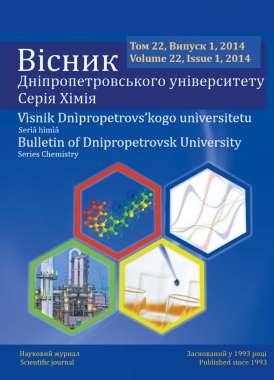Theoretical study of ionization potentials of N-heterocyclic compounds
DOI:
https://doi.org/10.15421/081410Keywords:
azacyclic compounds, DFT, ionization potentialAbstract
The ability to predict the redox properties is an important tool for study electron transfer processes occurring in the gas-phase (atmospheric chemistry) or in the condensed phase (electrochemistry, biochemistry). MPWB1K/6-31+G(d) and MPWB1K/tzvp theoretical models were found to provide reasonable accuracy of the prediction of ionization potentials for mono- and polycyclic azacompounds. The root mean square errors of the methods are 0.19 and 0.20, respectively. While the mean absolute deviation for both methods is the same and equals to 0.15 eV. These theoretical models were applied to predict ionization potentials for compounds not evaluated experimentally. Influence of substitutes and a number of nitrogen atoms on value of ionization potential was analyzed. Methyl-, and phenyl- groups, and fused benzo cycle decrease ionization potentials of N-heterocycles. Increase of amount of nitrogen atoms in five-membered cycles leads to significant enlargement of ionization potentials.References
Zhan C.-G., Nichols J. A., Dixon D. A., J. Phys. Chem. A, 2003, vol. 107, no 20, p. 4184-4195.
Uchimiya M., Gorb L., Isayev O., Qasim M. M., Leszczynski J., Environ Pollut., 2010, vol. 158, no. 10, p. 3048-3053.
Namazian M., Coote M. L., J. Phys. Chem. A, 2007, vol. 111, no. 30, p. 7227-7132.
Rayne S., Forest K., J. Chem. Eng. Data., 2011, vol. 56, no. 2, p. 350-355.
Fu Y., Liu L., Yu H.-Z., Wang Y.-M., Guo Q.-X., J. Am. Chem. Soc., 2005, vol. 127, no. 19, 7227-7234.
Xu W., Gao A., J. Mol. Struct: THEOCHEM, 2005, vol. 732, no. 1-3, p. 63-70.
Kose M., Theor. Chem. Acc., 2011, vol. 128, no. 2, p. 157-164.
Sviatenko L., Isayev O., Gorb L., Hill F., Leszczynski J., J. Comput. Chem., 2011, vol. 32, no. 10, p. 2195-2203.
Sviatenko L. K., Gorb L., Hill F., Leszczynski J., J. Comput. Chem., 2013, vol. 34, no. 13, p. 1094-1100.
Shankar R., Senthilkumar K., Kolandaivel P., Int. J. Quantum Chem., 2009, vol. 109, no. 4, p. 764-771.
Frisch, M. J., Trucks, G. W., Schlegel, H. B. et al., Gaussian 09, Revision A.02, Gaussian, Inc.: Wallingford CT, 2009.
Zhao Y., Truhlar D. G., J. Phys. Chem. A, 2004, vol. 108, no. 33, p. 6908-6918.
NIST Chemistry WebBook. NIST Standard Reference Database, 2005, no. 69. Available at http://webbook.nist.gov/chemistry/.
Downloads
Published
Issue
Section
License
Copyright (c) 2014 Oles Honchar Dnipropetrovsk National University

This work is licensed under a Creative Commons Attribution 4.0 International License.
- Authors reserve the right of attribution for the submitted manuscript, while transferring to the Journal the right to publish the article under the Creative Commons Attribution License. This license allows free distribution of the published work under the condition of proper attribution of the original authors and the initial publication source (i.e. the Journal)
- Authors have the right to enter into separate agreements for additional non-exclusive distribution of the work in the form it was published in the Journal (such as publishing the article on the institutional website or as a part of a monograph), provided the original publication in this Journal is properly referenced
- The Journal allows and encourages online publication of the manuscripts (such as on personal web pages), even when such a manuscript is still under editorial consideration, since it allows for a productive scientific discussion and better citation dynamics (see The Effect of Open Access).


